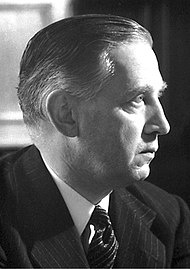Edward Victor Appleton
Sir Edward Victor Appleton GBE KCB FRS[3] (6 September 1892 – 21 Aprile 1965) wis an Inglis pheesicist.[4][5] Nobel Prize winner an pioneer in radio pheesics. He studied, an wis an aa employed as a Lab Technician, at Bradford Technical College frae 1909 tae 1911.
Sir Edward Appleton | |
|---|---|
 | |
| Born | Edward Victor Appleton 6 September 1892 Bradford, West Riding of Yorkshire, Ingland, UK |
| Dee'd | 21 Apryle 1965 (aged 72) Edinburgh, Scotland, UK |
| Naitionality | Inglis |
| Alma mater | Bradford College St John's College, Cambridge |
| Kent for | Ionospheric Pheesics[1][2] Appleton layer Demonstrating existence of Kennelly–Heaviside layer |
| Awairds | Nobel Prize in Pheesics (1947) Fellae o the Ryal Society (1927)[3] Hughes Medal (1933) Faraday Medal (1946) Chree Medal (1947) Ryal Medal (1950) Albert Medal (1950) IEEE Medal o Honour (1962) |
| Scientific career | |
| Fields | Pheesics |
| Institutions | King's College London Varsity o Cambridge Varsity o Edinburgh Cavendish Laboratory |
| Academic advisors | J. J. Thomson Ernest Rutherford |
| Notable students | J. A. Ratcliffe Charles Oatley |
He wan the Nobel Prize in Pheesics in 1947 for his seminal wirk provin the exeestence o the ionosphere during experiments carried oot in 1924.
References eedit
- ↑ Appleton, E. V. (1946). "Two Anomalies in the Ionosphere". Nature. 157 (3995): 691. Bibcode:1946Natur.157..691A. doi:10.1038/157691a0.
- ↑ Appleton, EV (1932). "Wireless Studies of the Ionosphere". J. Inst. Elec. Engrs. doi:10.1049/jiee-1.1932.0144.
- ↑ a b Ratcliffe, J. A. (1966). "Edward Victor Appleton 1892–1965". Biographical Memoirs of Fellows of the Royal Society. 12: 1–19. doi:10.1098/rsbm.1966.0001.
- ↑ "Sir Edward Appleton (1892–1965)".
- ↑ "Sir Edward Appleton". Physics Today. 18 (9): 113. 1965. doi:10.1063/1.3047706.